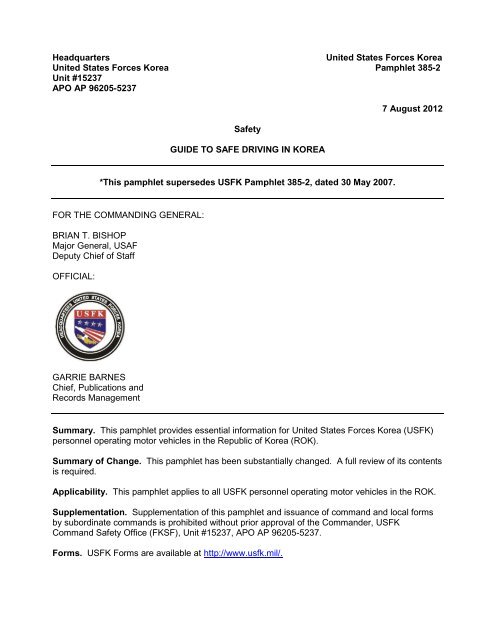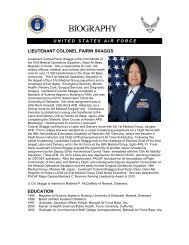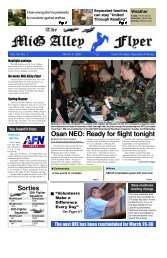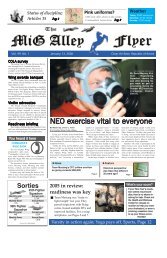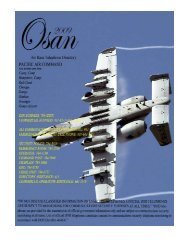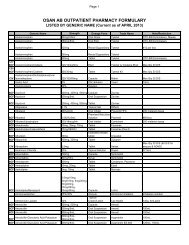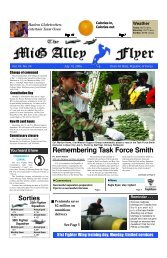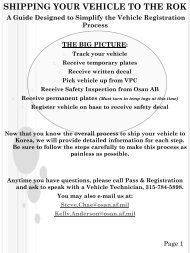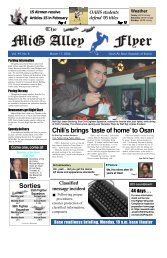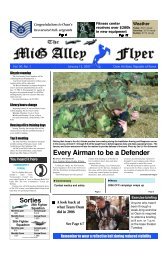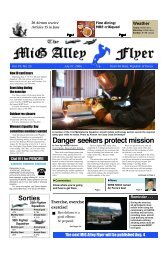USFK 385-2 Guide to Safe Driving in Korea - U.S. Army
USFK 385-2 Guide to Safe Driving in Korea - U.S. Army
USFK 385-2 Guide to Safe Driving in Korea - U.S. Army
Create successful ePaper yourself
Turn your PDF publications into a flip-book with our unique Google optimized e-Paper software.
HeadquartersUnited States Forces <strong>Korea</strong>United States Forces <strong>Korea</strong> Pamphlet <strong>385</strong>-2Unit #15237APO AP 96205-5237<strong>Safe</strong>tyGUIDE TO SAFE DRIVING IN KOREA7 August 2012*This pamphlet supersedes <strong>USFK</strong> Pamphlet <strong>385</strong>-2, dated 30 May 2007.FOR THE COMMANDING GENERAL:BRIAN T. BISHOPMajor General, USAFDeputy Chief of StaffOFFICIAL:GARRIE BARNESChief, Publications andRecords ManagementSummary. This pamphlet provides essential <strong>in</strong>formation for United States Forces <strong>Korea</strong> (<strong>USFK</strong>)personnel operat<strong>in</strong>g mo<strong>to</strong>r vehicles <strong>in</strong> the Republic of <strong>Korea</strong> (ROK).Summary of Change. This pamphlet has been substantially changed. A full review of its contentsis required.Applicability. This pamphlet applies <strong>to</strong> all <strong>USFK</strong> personnel operat<strong>in</strong>g mo<strong>to</strong>r vehicles <strong>in</strong> the ROK.Supplementation. Supplementation of this pamphlet and issuance of command and local formsby subord<strong>in</strong>ate commands is prohibited without prior approval of the Commander, <strong>USFK</strong>Command <strong>Safe</strong>ty Office (FKSF), Unit #15237, APO AP 96205-5237.Forms. <strong>USFK</strong> Forms are available at http://www.usfk.mil/.
Records Management. Records created as a result of processes prescribed by this regulationmust be identified, ma<strong>in</strong>ta<strong>in</strong>ed, and disposed of accord<strong>in</strong>g <strong>to</strong> AR 25-400-2. Record titles anddescriptions are available on the <strong>Army</strong> Records Information System website at:https://www.arims.army.mil.Suggested Improvements. The proponent of this regulation is the <strong>USFK</strong> Command <strong>Safe</strong>ty Office(FKSF). Users are <strong>in</strong>vited <strong>to</strong> send comments and suggested improvements on DA Form 2028(Recommended Changes <strong>to</strong> Publications and Blank Forms) <strong>to</strong> the <strong>USFK</strong> Command <strong>Safe</strong>ty Office(FKSF), Unit #15237, APO AP 96205-5237.Interim Changes. Interim changes <strong>to</strong> this pamphlet are no official unless authenticated by theCommand <strong>Safe</strong>ty Office. Users will destroy <strong>in</strong>terim changes on their expiration date unless soonersuperseded of resc<strong>in</strong>ded.Distribution. Electronic Media Only (EMO).
CONTENTSChapter 1Introduction, page 11-1. Purpose1-2. References1-3. Explanation of AbbreviationsChapter 2Vehicle <strong>Safe</strong>ty Inspection Requirements, page 1Chapter 3Driver Licenses, page 2Chapter 4<strong>Driv<strong>in</strong>g</strong> Rules, page 24-1. Traffic Signals and Directions4-2. Traffic Lanes4-3. Right-of-Way4-4. Speed Limits4-5. Pass<strong>in</strong>g4-6. <strong>Driv<strong>in</strong>g</strong> through Intersections4-7. Vehicle Lights4-8. Driver Responsibilities4-9. Park<strong>in</strong>g4-10. Passenger and Cargo LimitationsChapter 5Special Provisions for Expressway <strong>Driv<strong>in</strong>g</strong>, page 155-1. Rules for Travel5-2. Vehicle Breakdown5-3. Drivers Responsibilities on The ExpresswayChapter 6Traffic Accidents, page 166-1. <strong>Korea</strong>n Mo<strong>to</strong>r Vehicle Laws6-2. Procedures after An AccidentChapter 7Additional Requirements for Military Vehicles, page 187-1. Vehicle Movement7-2. Highway Condition Codes7-3. Maximum <strong>USFK</strong> Vehicle Speed Limits (<strong>USFK</strong> Reg 190-1)7-4. Traffic Po<strong>in</strong>t System
CONTENTS (Cont)Chapter 8Mo<strong>to</strong>rcycle and Bicycle <strong>Safe</strong>ty Rules and Devices, page 208-1. Mo<strong>to</strong>rcycle/Moped8-2. Bicycle <strong>Safe</strong>tyAppendixes, page 22A. <strong>Korea</strong>n Road Traffic SignsB. Driver’s Assistance RequestTable List4-1. Approximate Equivalents of Common Measurements Used <strong>in</strong> <strong>Driv<strong>in</strong>g</strong>, page 9Figure List4-1. Traffic Signal, page 34-2. Example of Improper Lane Change 1, page 44-3. Example of Improper Lane Change 2, page 44-4. Use of Directional Signal (City <strong>Driv<strong>in</strong>g</strong>), page 54-5. Bus Lane, page 64-6. Unprotected Left Turn, page 64-7. Lane by the Type of Vehicle, page 74-8. Right-of-Way (Descend<strong>in</strong>g Vehicle), page 84-9. Right-of-Way (Loaded Vehicle), page 84-10. Speed and Force of Impact, page 94-11. Prohibited Pass<strong>in</strong>g, page 104-12. Traffic Sign – Do Not Pass, page 104-13. Crosswalk, page 125-1. Use of Directional Signal (Highway <strong>Driv<strong>in</strong>g</strong>), page 155-2. Location of Warn<strong>in</strong>g Sign, page 15Glossary, page 29
Chapter 1Introduction1-1. PurposeThis pamphlet provides essential <strong>in</strong>formation for United States Forces <strong>Korea</strong> (<strong>USFK</strong>) personneloperat<strong>in</strong>g mo<strong>to</strong>r vehicles <strong>in</strong> the Republic of <strong>Korea</strong> (ROK).1-2. Referencesa. <strong>USFK</strong> Regulation 201-1, Environmental Govern<strong>in</strong>g Standardsb. <strong>USFK</strong> Regulation 190-1, Mo<strong>to</strong>r Vehicle Traffic Supervisionc. <strong>Korea</strong>n Road Traffic Laws1-3. Explanation of AbbreviationsAbbreviations used <strong>in</strong> this pamphlet are listed <strong>in</strong> the glossary.Chapter 2Vehicle <strong>Safe</strong>ty Inspection RequirementsAll Private Owned Vehicles (POVs) will undergo a safety <strong>in</strong>spection--a. All POVs will undergo a safety <strong>in</strong>spection before registration. Vehicle Emission Test<strong>in</strong>g willbe <strong>in</strong>corporated as a component of the <strong>Safe</strong>ty Inspection IAW <strong>USFK</strong> Regulation 201-1, paragraph2-3g. The POVs will be <strong>in</strong>spected each time the vehicle is re-registered, unless otherwiseexempted by this regulation. Vehicles not comply<strong>in</strong>g with this regulation will not be registered orissued a <strong>USFK</strong> Vehicle Registration Decal until necessary repairs are made.b. Before registration, POVs must pass a safety <strong>in</strong>spection conducted with<strong>in</strong> the last 30 days,at a facility designated by the United States (U.S.) <strong>Army</strong> Area Commander or United States AirForce (USAF) Support Group Commander and at least biennial from date of <strong>in</strong>itial registration.Invited contrac<strong>to</strong>rs, their U.S. and third-country national employees, and their family members mus<strong>to</strong>bta<strong>in</strong> a vehicle <strong>in</strong>spection certificate issued by the ROK Government <strong>in</strong> lieu of the safety<strong>in</strong>spection.c. Vehicle <strong>in</strong>spection facilities will <strong>in</strong>spect POVs <strong>in</strong> accordance with (IAW) the vehiclestandards <strong>in</strong> this regulation and for general mechanical fitness and safety. Vehicles must beequipped with a warn<strong>in</strong>g device (warn<strong>in</strong>g triangle or traffic flares) prior <strong>to</strong> registration. Vehiclesrequir<strong>in</strong>g repair will be provided an <strong>in</strong>spection certificate stamped "REJECTED". This certificatewill show any required repairs and that re-<strong>in</strong>spection must be done with<strong>in</strong> 15 days. An additional30 days may be granted on a one-time basis <strong>in</strong> accordance with procedures established by theArea Commander.d. The safety <strong>in</strong>spection of the POV will be conducted dur<strong>in</strong>g the same month as the <strong>in</strong>itial<strong>in</strong>spection. Inspection certificates will rema<strong>in</strong> with the vehicle except <strong>to</strong> present it <strong>to</strong> the VehicleRegistration Office for re-registration.1<strong>USFK</strong> PAM <strong>385</strong>-2, 7 August 2012
Chapter 3Driver LicensesAll Status of Forces Agreement (SOFA) members of <strong>USFK</strong>-a. All SOFA members of <strong>USFK</strong> military, the civilian component (<strong>in</strong>clud<strong>in</strong>g technicalrepresentatives), and their family members who drive POVs on U.S. <strong>in</strong>stallation and <strong>in</strong> the ROKmust possess a <strong>USFK</strong> Form 134EK. The aforementioned personnel must also possess a validU.S. state driver’s license, ROK driver’s license or <strong>in</strong>ternational driver’s license permit prior <strong>to</strong>issuance of a <strong>USFK</strong> 134EK.<strong>USFK</strong> Invited Contrac<strong>to</strong>r and <strong>USFK</strong> third-country national employees and their family members areauthorized, but not required, <strong>to</strong> obta<strong>in</strong> a <strong>USFK</strong> 134EK as long as they are first <strong>in</strong> possess of a ROKdriver’s license or valid <strong>in</strong>ternational driver’s permit prior <strong>to</strong> issuance of a <strong>USFK</strong> Form 134EK. (Ref<strong>USFK</strong> Reg 190-1)b. The <strong>USFK</strong> 134EK is valid for—(1) Military and their family members, Department of Defense (DOD) civilians and theirfamily members, and technical representatives and their family members - Five (5) years.(2) Invited contrac<strong>to</strong>rs (<strong>in</strong>clud<strong>in</strong>g third-country national employees) and their familymembers - Until DEROS established by contract or term<strong>in</strong>ation of contract, whichever comes first.(3) Chauffeurs - same as sponsor.Chapter 4<strong>Driv<strong>in</strong>g</strong> Rules4-1. Traffic Signals and Directionsa. Drivers must obey traffic signals and directions.(1) Drivers must obey signal lights, traffic signs, and directions given by a traffic policeofficer or assistant traffic controller.(2) When a police officer is direct<strong>in</strong>g traffic, drivers should follow the hand signals or theflashlight signal by the police officer even if they are contradic<strong>to</strong>ry <strong>to</strong> traffic signals. Manual controlby the police takes priority.b. Traffic signal lights and their mean<strong>in</strong>g.(1) Red signal -(a) Vehicles must come <strong>to</strong> a complete s<strong>to</strong>p before reach<strong>in</strong>g the s<strong>to</strong>p l<strong>in</strong>e, pedestriancrosswalk, or <strong>in</strong>tersection.(b) A vehicle may turn right, provided it will not <strong>in</strong>terfere witha pedestrian or right-of way vehicle.(2) Yellow signal - A driver must come <strong>to</strong> a complete s<strong>to</strong>p before reach<strong>in</strong>g the s<strong>to</strong>p l<strong>in</strong>e, apedestrian crosswalk, or an <strong>in</strong>tersection. If a driver is already <strong>in</strong> the <strong>in</strong>tersection, he or she mustproceed as quickly as possible when safe.2<strong>USFK</strong> PAM <strong>385</strong>-2, 7 August 2012
(3) Green signal - Driver may either go straight ahead or turn right.―No left turn may be made unless otherwise directed‖(4) Green arrow signal - Driver may go <strong>in</strong> the direction of the green <strong>in</strong>dica<strong>to</strong>r.(5) Lane direction and control signals - when lane direction control signals are placedover separate lanes of a street or highway, vehicular traffic may travel <strong>in</strong> any lane over which agreen signal is lighted but will not enter or travel <strong>in</strong> any lane where a red signal is displayed.(6) Reversible Lane Signals - With<strong>in</strong> certa<strong>in</strong> areas of major cities, the overhead X anddownward arrow signal devices are used where the direction of heavy traffic volume changesdur<strong>in</strong>g certa<strong>in</strong> peak hours of the day. These signals override the lane marks/centerl<strong>in</strong>e on thepavement.(a) Red X Light - Vehicles will not use the lane shown with red X signal.light.(b) Green Downward Arrow - Vehicles may proceed <strong>in</strong> the lane shown with green arrow(7) Flash<strong>in</strong>g red (s<strong>to</strong>p signal). Drivers of vehicles must s<strong>to</strong>p at the marked s<strong>to</strong>p l<strong>in</strong>e. Ifthere is no l<strong>in</strong>e, a s<strong>to</strong>p must be made before enter<strong>in</strong>g the crosswalk on the near side of the<strong>in</strong>tersection, or at the po<strong>in</strong>t nearest the <strong>in</strong>tersect<strong>in</strong>g roadway where the driver has a view ofapproach<strong>in</strong>g traffic on the <strong>in</strong>tersect<strong>in</strong>g roadway. The right <strong>to</strong> proceed is subject <strong>to</strong> the rulesapplicable after mak<strong>in</strong>g a s<strong>to</strong>p.(8) Flash<strong>in</strong>g yellow (caution signal). Drivers of vehicles may proceed through the<strong>in</strong>tersection while exercis<strong>in</strong>g due caution.Figure 4-1. Traffic Signal4-2. Traffic Lanesa. When traffic lanes are marked, drivers must stay <strong>in</strong> the lane for the type of vehicle ispermitted. Drivers may not drive over the lane divider l<strong>in</strong>e.b. Examples of improper driv<strong>in</strong>g <strong>in</strong>volv<strong>in</strong>g traffic lane mark<strong>in</strong>gs are -3<strong>USFK</strong> PAM <strong>385</strong>-2, 7 August 2012
side of dotted l<strong>in</strong>es may cross the l<strong>in</strong>es <strong>to</strong> pass. White dotted or solid l<strong>in</strong>es are lane dividers. Avehicle may not cross a solid lane divider <strong>to</strong> change lanes.c. Chang<strong>in</strong>g lanes -(1) Drivers must use directional signal at least 30 meters prior <strong>to</strong> turn<strong>in</strong>g (100 meters onthe expressway).Figure 4-4. Use of Directional Signal (City <strong>Driv<strong>in</strong>g</strong>)(2) Drivers must not change directions where prohibited by traffic signs.(3) Chang<strong>in</strong>g lanes is prohibited when--d. Bus lane:(a) There is <strong>in</strong>sufficient distance <strong>to</strong> do so safely.(b) With<strong>in</strong> 70 meters from the s<strong>to</strong>p l<strong>in</strong>e at an <strong>in</strong>tersection.(1) The bus lane (<strong>in</strong> cities) has been established <strong>to</strong> limit traffic. It is marked by a blue l<strong>in</strong>eand it designates a lane <strong>to</strong> be used only by buses. Supplemental signs normally show the timewhen no vehicles other than buses will travel <strong>in</strong> the lane. At <strong>in</strong>tersections the bus lane will have abroken or dash l<strong>in</strong>es, vehicles other than buses may enter this bus lane <strong>to</strong> make a right turn or <strong>to</strong>immediately exit the ma<strong>in</strong> street.(2) Median (center) bus lane <strong>in</strong> Seoul is marked <strong>in</strong> red around the bus s<strong>to</strong>p areas onlyand it designates a lane <strong>to</strong> be used only by buses 24 hours a day. Do not use this lane for anyreason. Drivers can only make U-turns at <strong>in</strong>tersections where designated signs are posted.Caution should be exercised around bus lanes as the buses will be travel<strong>in</strong>g at a muchhigher rate of speed than normal city traffic.(3) Bus lanes on the Gyeongbu expressway (Highway #1) have been designated <strong>to</strong> beused only by buses and 9-passenger vans hav<strong>in</strong>g at least 6 passengers. It is marked by a bluel<strong>in</strong>e.5<strong>USFK</strong> PAM <strong>385</strong>-2, 7 August 2012
3 Lanes(One-way)1st Lane2nd lane3rd laneSedans, station wagons, 1.5 <strong>to</strong>n and below pickuptrucks and vehicles of similar design and function.Sedans, station wagons, 1.5 <strong>to</strong>n and over, pickuptrucks, trucks, and buses.Mo<strong>to</strong>rcycles, bicycles, carts, and trucks <strong>to</strong>w<strong>in</strong>g trailersor other construction trucks.Figure 4-7. Lane by The Type of VehicleNOTE: First lane (closest <strong>to</strong> the center l<strong>in</strong>e) then number <strong>to</strong> the right curb.4-3. Right-of-Waya. When an authorized emergency vehicle approaches, with a siren or a flash<strong>in</strong>g light on post,or siren and flash<strong>in</strong>g light off post, all traffic is required <strong>to</strong> yield the right-of-way by mov<strong>in</strong>g as far <strong>to</strong>the right or far left side of the road as possible (depends upon your location) and s<strong>to</strong>pp<strong>in</strong>g until theemergency vehicle has passed. However, ensure you don’t s<strong>to</strong>p at the <strong>in</strong>tersection. Rember it isnormal <strong>in</strong> off post traffic for On-Duty Emergency vehicles <strong>to</strong> travel with their emergency lights on.b. Right-of-way laws def<strong>in</strong>e who has the right of way. NEVER INSIST ON TAKING THERIGHT-OF-WAY. Wait until it is yielded <strong>to</strong> you. All drivers have a moral and legal responsibility <strong>to</strong>avoid a collision. Courtesy and cooperation among drivers helps prevent accidents and makesdriv<strong>in</strong>g more pleasant.c. At <strong>in</strong>tersections without STOP or YIELD signs or traffic signals--(1) The first vehicle <strong>in</strong> the <strong>in</strong>tersection should be allowed <strong>to</strong> go ahead.(2) If two drivers reach an <strong>in</strong>tersection from different streets at the same time, the driver ofthe vehicle on the left must give the right-of-way <strong>to</strong> the vehicle on the right.(3) When you see a vehicle cross<strong>in</strong>g or beg<strong>in</strong>n<strong>in</strong>g <strong>to</strong> cross the road you are driv<strong>in</strong>g on,slow down, prepare <strong>to</strong> s<strong>to</strong>p, and let it go ahead.d. Yield the right-of-way <strong>to</strong> faster mov<strong>in</strong>g vehicles. Regardless of the speed at which you aretravel<strong>in</strong>g, you must not obstruct another driver so he cannot pass. When driv<strong>in</strong>g on a roadwaywide enough for more than one l<strong>in</strong>e of vehicles <strong>in</strong> your direction of travel, you must move out of theleft hand lane when another vehicle is close beh<strong>in</strong>d you and try<strong>in</strong>g <strong>to</strong> pass. Vehicles which must7<strong>USFK</strong> PAM <strong>385</strong>-2, 7 August 2012
move at slower speeds must travel <strong>in</strong> the lane farthest <strong>to</strong> the right or <strong>in</strong> a lane marked for them bysigns.e. Right-of-way is def<strong>in</strong>ed by road condition.(1) On a narrow <strong>in</strong>cl<strong>in</strong>ed road, the descend<strong>in</strong>g vehicle has right-of-way. Ascend<strong>in</strong>g vehiclemust pull over <strong>to</strong> the right.Figure 4-8. Right-Of-Way (Descend<strong>in</strong>g Vehicle)(2) On a narrow road, a vehicle with passengers or cargo has the right-of-way. Unloadedvehicle must pull over the right.Figure 4-9. Right-Of-Way (Loaded Vehicle)4-4. Speed Limitsa. Speed limits <strong>in</strong> this paragraph do not apply <strong>to</strong> official <strong>USFK</strong> vehicles. (See chapter 7 forofficial <strong>USFK</strong> vehicle speed limits.) Speed limits established by the law must be observed. Oftenthe speed limit is set by <strong>in</strong>dividual traffic signs. When these signs are used, the posted speedlimits must be observed.8<strong>USFK</strong> PAM <strong>385</strong>-2, 7 August 2012
(1) Speed reduction dur<strong>in</strong>g <strong>in</strong>clement weather. Vehicle opera<strong>to</strong>r should reduce speed by20 <strong>to</strong> 50 percent when driv<strong>in</strong>g <strong>in</strong> snow, fog, ice, or ra<strong>in</strong>.(2) Speed and force of impact. (Pic<strong>to</strong>rial comparison)Figure 4-10. Speed and Force of Impactb. Metric System. The metric system is used <strong>in</strong> <strong>Korea</strong>. Speed limit or distance is shown <strong>in</strong>meters or kilometers rather than feet or miles. For a quick mental conversion, multiply kilometersby .6 for approximate miles, or multiply miles by 1.6 for approximate kilometers (e.g., 40 km x .6 =24 miles, or 30 miles x 1.6 = 48 kilometers). The table below shows approximate equivalents ofcommon measurements used <strong>in</strong> driv<strong>in</strong>g.Table 4-1Approximate Equivalents of Common Measurements Used <strong>in</strong> <strong>Driv<strong>in</strong>g</strong>FEET METERS MILES KILOMETERS1 0.3048 1 1.609310 3 10 1615 4.6 15 24100 30 19 30200 61 25 40300 91 31 50400 122 37 60500 152 43 7050 8055 8862 10068 1104-5. Pass<strong>in</strong>ga. Method of pass<strong>in</strong>g.(1) To alert vehicles ahead, driver must <strong>in</strong>dicate <strong>in</strong> advance the <strong>in</strong>tention <strong>to</strong> pass.9<strong>USFK</strong> PAM <strong>385</strong>-2, 7 August 2012
(2) Driver must pass <strong>to</strong> the left of a vehicle travel<strong>in</strong>g <strong>in</strong> the same direction. <strong>Safe</strong> pass<strong>in</strong>gmust be accomplished after <strong>in</strong>sur<strong>in</strong>g adequate clearance and the speed of vehicles <strong>in</strong> front of, <strong>to</strong>the rear of, and on-com<strong>in</strong>g traffic.b. Places where pass<strong>in</strong>g is prohibited.(1) On or near the <strong>to</strong>p of steep grades.(2) On curves.Figure 4-11. Prohibited Pass<strong>in</strong>g(3) Descend<strong>in</strong>g lane on a steep <strong>in</strong>cl<strong>in</strong>e.(4) Inside a tunnel.(5) Intersections.(6) Where prohibited by traffic signs.Figure 4-12. Traffic Sign – Do not Pass4-6. <strong>Driv<strong>in</strong>g</strong> through Intersectionsa. Method of enter<strong>in</strong>g.10<strong>USFK</strong> PAM <strong>385</strong>-2, 7 August 2012
(1) Vehicles turn<strong>in</strong>g right must first move slowly <strong>to</strong> the lane nearest the right hand curb.(2) Vehicles turn<strong>in</strong>g left must do so from the left hand edge of the lane closest <strong>to</strong> thecenterl<strong>in</strong>e and from the center po<strong>in</strong>t of the <strong>in</strong>tersection.(3) Vehicles turn<strong>in</strong>g or go<strong>in</strong>g straight must move slowly <strong>to</strong> the appropriate lane at least 70meters prior <strong>to</strong> the white l<strong>in</strong>e at the <strong>in</strong>tersection.b. Pedestrians. Pedestrians have the right-of-way at <strong>in</strong>tersections and marked pedestriancrosswalks.(1) Drivers will yield <strong>to</strong> pedestrians cross<strong>in</strong>g at green cross<strong>in</strong>g signals.(2) Drivers will yield <strong>to</strong> pedestrians cross<strong>in</strong>g the road at or near <strong>in</strong>tersections where trafficis not be<strong>in</strong>g controlled.c. Extreme caution must be employed when enter<strong>in</strong>g <strong>in</strong><strong>to</strong> <strong>in</strong>tersections after a traffic signalhas changed from red <strong>to</strong> green.4-7. Vehicle Lightsa. Requirements.(1) Vehicles must have headlights, clearance lights, taillights, and license plate light litwhen driv<strong>in</strong>g at night. (Night is def<strong>in</strong>ed as a half hour after sunset until a half hour before sunrise.)(2) When objects cannot be seen with<strong>in</strong> 100 meters dur<strong>in</strong>g the day due <strong>to</strong> <strong>in</strong>clementweather, lights must be turned on the same as if driv<strong>in</strong>g at night. When driv<strong>in</strong>g through fog, it isbest <strong>to</strong> use low beams.b. Use of low beams.(1) When travel<strong>in</strong>g through a high density traffic area at night, low beams must becont<strong>in</strong>uously used.(2) When encounter<strong>in</strong>g on-com<strong>in</strong>g traffic at night, dim the headlights <strong>to</strong> prevent otherdrivers from be<strong>in</strong>g bl<strong>in</strong>ded.(3) When a vehicle is s<strong>to</strong>pped or parked on the roadway at night, park<strong>in</strong>g lights orclearance lights must be on.4-8. Driver Responsibilitiesa. Drivers are responsible <strong>to</strong> abide by <strong>Korea</strong>n Law and posted speed limits and restrictions.Speed limits and designated bus lane established by the law must be observed.b. Accord<strong>in</strong>g <strong>to</strong> <strong>USFK</strong> Regulation 190-1, paragraph 2-4, and its rule titled: ―Implied Consent <strong>to</strong>Blood, Breath or Ur<strong>in</strong>e Tests‖, Persons who operate a mo<strong>to</strong>r vehicle, mo<strong>to</strong>rcycle, moped or bicycleon a military <strong>in</strong>stallation/garrison au<strong>to</strong>matically give their consent <strong>to</strong> chemical tests for alcohol ordrug content of their blood, breath or ur<strong>in</strong>e. It is implied that, if lawfully s<strong>to</strong>pped, apprehended orcited for an offense committed while driv<strong>in</strong>g or <strong>in</strong> control of a mo<strong>to</strong>r vehicle, mo<strong>to</strong>rcycle, moped or11<strong>USFK</strong> PAM <strong>385</strong>-2, 7 August 2012
icycle, the <strong>in</strong>dividual has given "implied consent" <strong>to</strong> the search of his/her person. An <strong>in</strong>dividual'srefusal under the "Implied Consent" provision will au<strong>to</strong>matically result <strong>in</strong> a one-year revocation ofdriv<strong>in</strong>g privileges.c. Splash<strong>in</strong>g. When driv<strong>in</strong>g <strong>in</strong> wet areas, drivers must not splash mud or water on pedestrians.d. Protection of children and the bl<strong>in</strong>d. When an unaccompanied child or a bl<strong>in</strong>d person with awhite cane is walk<strong>in</strong>g on the road, the vehicle must come <strong>to</strong> a complete s<strong>to</strong>p.Figure 4-13. Crosswalke. Protection of pedestrians at crosswalks. When a pedestrian is <strong>in</strong> a crosswalk, vehicles musts<strong>to</strong>p completely. Slow down and prepare <strong>to</strong> s<strong>to</strong>p when approach<strong>in</strong>g a s<strong>to</strong>pped or parked vehiclenear a crosswalk. Pedestrians may be cross<strong>in</strong>g <strong>in</strong> front of the s<strong>to</strong>pped or parked vehicle.f. On U.S. Installations: Do not pass or overtake a school bus or shuttle bus when buses areload<strong>in</strong>g or unload<strong>in</strong>g passengers, as <strong>in</strong>dicated by flash<strong>in</strong>g lights or directed observation. Vehiclestravel<strong>in</strong>g <strong>in</strong> either direction of a s<strong>to</strong>pped school bus/shuttle bus must s<strong>to</strong>p.g. Driver attendance. When leav<strong>in</strong>g a vehicle, drivers must make sure that the mo<strong>to</strong>r is turnedoff, the park<strong>in</strong>g brake is set, and the vehicle is locked so that it cannot be driven by another person.h. Use of horns. The use of horns is prohibited <strong>in</strong> designated areas with<strong>in</strong> major cities.i. Alcohol and drugs. <strong>Driv<strong>in</strong>g</strong> while under the <strong>in</strong>fluence of drugs or alcohol is prohibited. Thelegal limit of <strong>in</strong><strong>to</strong>xication is 0.5mg (0.05%) or more of alcohol per 1ml of blood.j. <strong>Safe</strong>ty restra<strong>in</strong>t usage.(1) All occupants of Government-owned vehicles, privately owned vehicles used for officialbus<strong>in</strong>ess, or any vehicle operated on a Federal <strong>in</strong>stallation, will wear manufacturer-<strong>in</strong>stalledrestra<strong>in</strong>t systems.(2) All <strong>USFK</strong> personnel will wear manufacturer-<strong>in</strong>stalled restra<strong>in</strong>t systems at all times whiledriv<strong>in</strong>g or rid<strong>in</strong>g <strong>in</strong> a POV, both on and off any <strong>USFK</strong> <strong>in</strong>stallation.(3) Individuals will not ride <strong>in</strong> seats from which manufacturer-<strong>in</strong>stalled occupant restra<strong>in</strong>tsystems have been removed or rendered <strong>in</strong>operative.12<strong>USFK</strong> PAM <strong>385</strong>-2, 7 August 2012
(4) Drivers are responsible <strong>to</strong> have front and rear seat passengers wear seat belts.(5) No vehicle opera<strong>to</strong>r will transport an <strong>in</strong>fant/child under 4 years of age and/or under 45pounds without be<strong>in</strong>g properly secured <strong>in</strong> an <strong>in</strong>fant/child restra<strong>in</strong> device (car seat). If eitherrequirement (age or weight) is not met, then the <strong>in</strong>fant/child must be transported <strong>in</strong> a car seat.k. Distractions:(1) Vehicle opera<strong>to</strong>rs must pay strict attention while driv<strong>in</strong>g. As such, vehicle opera<strong>to</strong>rs areprohibited from the wear of commercial headsets/headphones or earplug radios. Drivers shouldnot eat or smoke while driv<strong>in</strong>g.(2) Vehicle opera<strong>to</strong>rs are restricted from us<strong>in</strong>g a Mobile Personal Electronic Device (MPED)on or off military <strong>in</strong>stallations such as a hand held cellular phones, I-Phone, Balckberry, PersonalDigital Assistant (PDA), or other similar devices for the specific purpose of send<strong>in</strong>g or read<strong>in</strong>g tex<strong>to</strong>r e-mail messages while driv<strong>in</strong>g unless the vehicle is safely parked or they are us<strong>in</strong>g a hands-freedevice. Earphones versions of hand free devices are prohibited.(3) Vehicle opera<strong>to</strong>rs are prohibited from watch<strong>in</strong>g enterta<strong>in</strong>ment media capable devices,such as but not limited <strong>to</strong> video mach<strong>in</strong>es, while the vehicle is <strong>in</strong> motion. An enterta<strong>in</strong>ment mediacapable device is def<strong>in</strong>ed as hav<strong>in</strong>g a device display<strong>in</strong>g videos or video feed visible <strong>to</strong> the vehicledriver that may distract the driver from pay<strong>in</strong>g full attention while driv<strong>in</strong>g. This means that <strong>in</strong> cardash mounted, <strong>in</strong> dash, or portable devices display<strong>in</strong>g anyth<strong>in</strong>g other than a navigation mapp<strong>in</strong>gsystem are prohibited <strong>to</strong> be viewed by the driver while they are driv<strong>in</strong>g. (This is <strong>in</strong>clusive of GPSdevices mounted on the dash board or <strong>in</strong> the dash that are also equipped with multi-media playerswhere the driver can watch TV, Video, DVD Record<strong>in</strong>gs, or other visual media other than anavigational map while the vehicle is <strong>in</strong> operation.)4-9. Park<strong>in</strong>ga. Illegal park<strong>in</strong>g significantly contributes <strong>to</strong> congestion and impedes the traffic flow on and offmilitary <strong>in</strong>stallations. All persons who have registered a vehicle are responsible for the proper useof that vehicle, <strong>in</strong>clud<strong>in</strong>g park<strong>in</strong>g. Accord<strong>in</strong>gly, any <strong>in</strong>dividual whose registered vehicle hasaccumulated more than two DD Form 1408 (Armed Forces Traffic Ticket) for park<strong>in</strong>g violationsdur<strong>in</strong>g a 60-day period may have his/her driv<strong>in</strong>g privileges suspended for a period of up <strong>to</strong> sixmonths at the discretion of the <strong>in</strong>stallation commander. .b. Prohibited park<strong>in</strong>g. Except when necessary <strong>to</strong> avoid conflict with other traffic or <strong>to</strong> complywith law or the direction of law enforcement personnel or an official traffic control device, no personwill park a vehicle--(1) On a sidewalk.(2) In a crosswalk.(3) In front of driveways.(4) On a bridge or other elevated structure upon a roadway.(5) With<strong>in</strong> a highway tunnel.(6) On railroad or streetcar tracks.13<strong>USFK</strong> PAM <strong>385</strong>-2, 7 August 2012
(7) At any place narrow enough <strong>to</strong> make pass<strong>in</strong>g difficult, dangerous, or impossible.(8) On a roadway or shoulder with<strong>in</strong> 100 feet (30 meters) of the crest of a hill.(9) Beside another vehicle parked parallel <strong>to</strong> the curb or on a roadway shoulder.(10) Where official signs prohibit park<strong>in</strong>g, where <strong>in</strong>stallation signs reserve park<strong>in</strong>g, whenthe curb<strong>in</strong>g is pa<strong>in</strong>ted yellow, or when the roadway is marked <strong>in</strong> yellow or white.(11) With<strong>in</strong> 20 feet (6 meters) of a fire hydrant, crosswalk, bus s<strong>to</strong>p or <strong>in</strong>tersection.(12) With<strong>in</strong> 20 feet (6 meters) of a driveway <strong>to</strong> any fire station or similar emergency facility,on the side of the street opposite the entrance <strong>to</strong> any fire station or similar emergency facility, orwith<strong>in</strong> 75 feet (23 meters) of the entrance.(13) With<strong>in</strong> 30 feet (9 meters) of the approach <strong>to</strong> any flash<strong>in</strong>g signal, s<strong>to</strong>p sign, yield sign,or traffic control signal located at the side of the roadway.(14) On a grassed or seeded area on U.S. military <strong>in</strong>stallations unless directed by properauthority.(15) S<strong>to</strong>p, park, or leave a vehicle attended or unattended where it is prohibited. In anyevent, an unobstructed width of the highway opposite a vehicle must be left for the free passage ofother vehicles, and a clear view of the s<strong>to</strong>pped vehicle must be available from a distance of 200feet (60 meters) <strong>in</strong> each direction.4-10. Passenger and Cargo Limitationsa. Passenger limitation. The number of passengers will not exceed the designated seat<strong>in</strong>gcapacity.b. Cargo limitation.(1) Do not exceed manufacturer’s recommended cargo weight limitation of the vehicle.(2) Contents of the cargo should not extend beyond one tenth of the vehicle length.(3) Width of cargo should not block or impair the rearview mirror.c. Warn<strong>in</strong>g signs for cargo that exceeds the length limit.edge.(1) Daylight. A red cloth, 30cm x 50cm or larger, must be affixed <strong>to</strong> the farthest protrud<strong>in</strong>g(2) Night time. A light or reflec<strong>to</strong>r must be fastened <strong>to</strong> the farthest protrud<strong>in</strong>g edge.14<strong>USFK</strong> PAM <strong>385</strong>-2, 7 August 2012
Chapter 5Special Provisions for Expressway <strong>Driv<strong>in</strong>g</strong>5-1. Rules for Travela. Right-of-way.(1) An emergency vehicle has the right-of-way.(2) A vehicle already on the expressway has the right-of-way.b. Pass<strong>in</strong>g.(1) When pass<strong>in</strong>g, drivers must turn on the directional signal, and then pass safely us<strong>in</strong>gthe left lane (pass<strong>in</strong>g lane). Upon completion of pass<strong>in</strong>g, he must return <strong>to</strong> the travel<strong>in</strong>g lane us<strong>in</strong>gthe right turn signal.(2) The follow<strong>in</strong>g figure depicts the use of directional signals when pass<strong>in</strong>g. When pass<strong>in</strong>gon the expressway, directional signals are used <strong>to</strong> <strong>in</strong>dicate a change, either <strong>to</strong> enter the pass<strong>in</strong>glane or the travel<strong>in</strong>g lane. When <strong>in</strong> the pass<strong>in</strong>g lane, the directional signal must be turned off.Figure 5-1. Use of Directional Signal (Highway <strong>Driv<strong>in</strong>g</strong>)5-2. Vehicle BreakdownWhen a vehicle is disabled and unable <strong>to</strong> travel on the expressway, move the vehicle <strong>to</strong> the rightside of the roadway and place a triangular warn<strong>in</strong>g sign 100 meters (daylight) and 200 meters(night time) or more beh<strong>in</strong>d the vehicle. Turn on the vehicle’s hazard lights (flashers) <strong>to</strong> provideadditional visibility. Flashers may also be used by other mo<strong>to</strong>rists <strong>to</strong> warn of emergency conditions(accident on or near the roadway, disabled vehicle, etc.) Flashers must be visible up <strong>to</strong> 500meters.Figure 5-2. Location of Warn<strong>in</strong>g Sign15<strong>USFK</strong> PAM <strong>385</strong>-2, 7 August 2012
5-3. Drivers Responsibilities on The Expresswaya. Drivers will ensure their passengers wear <strong>in</strong>stalled seatbelts.b. Warn<strong>in</strong>g devices (warn<strong>in</strong>g triangular or traffic flares) must be carried at all times <strong>in</strong>clud<strong>in</strong>gexpressway travel<strong>in</strong>g. (Exception: Vehicles carry<strong>in</strong>g flammable or explosive materials will not useor carry flares.)c. If you travel on the Kyongbu expressway (Highway #1) observe the bus lane rule. The buslane is reserved for the buses and the 9-passenger vans with m<strong>in</strong>imum 6 personnel on board. Seeparagraph 4-2d, bus lane, for further <strong>in</strong>formation.d. Don’t drive along the side or shoulder of the expressway and be aware of stalled andemergency vehicles <strong>in</strong> this area.e. Slow down when go<strong>in</strong>g <strong>in</strong> and out of a tunnel because your vision needs <strong>to</strong> adjust <strong>to</strong> thechange <strong>in</strong> light<strong>in</strong>g.f. Ma<strong>in</strong>ta<strong>in</strong> a safe distance between your car and any car <strong>in</strong> front of you. Allow at least one carlength for each 10 MPH / 16 KPH (e.g., three car lengths if you are driv<strong>in</strong>g 30 MPH / 48 KPH).Apply the ―3-Second Rule‖.g. When you are <strong>in</strong> need of help from a <strong>Korea</strong>n, and you cannot communicate, use AppendixB of this pamphlet <strong>to</strong> po<strong>in</strong>t out the messages you wish <strong>to</strong> convey.Chapter 6Traffic Accidents6-1. <strong>Korea</strong>n Mo<strong>to</strong>r Vehicle Lawsa. All <strong>USFK</strong> members, <strong>in</strong>clud<strong>in</strong>g military members, DOD civilians, and family members, aresubject <strong>to</strong> <strong>Korea</strong>n mo<strong>to</strong>r vehicle laws. <strong>Korea</strong>n law requires that the driver of a mo<strong>to</strong>r vehicleexercise a high degree of care <strong>to</strong> avoid an accident. A driver who fails <strong>to</strong> exercise that duty of careand causes an accident is subject <strong>to</strong> civil and crim<strong>in</strong>al liability.b. Crim<strong>in</strong>al liability:(1) Under <strong>Korea</strong>n crim<strong>in</strong>al law, any driver of a mo<strong>to</strong>r vehicle is considered a professionaldriver. Consequently, a driver <strong>in</strong>volved <strong>in</strong> an accident result<strong>in</strong>g <strong>in</strong> death or <strong>in</strong>jury may be foundguilty of occupational negligence and subject <strong>to</strong> imprisonment for a maximum of five (5) years or af<strong>in</strong>e of 20 million Won. If a driver flees the scene of an accident, the penalty is <strong>in</strong>creased and couldresult <strong>in</strong> imprisonment for life.(2) Under a special statute, a driver found at fault <strong>in</strong> an accident result<strong>in</strong>g <strong>in</strong> <strong>in</strong>juries orproperty damage may be relieved from crim<strong>in</strong>al liability if the driver enters <strong>in</strong><strong>to</strong> a private settlementagreement or has an open-ended comprehensive <strong>in</strong>surance policy cover<strong>in</strong>g bodily <strong>in</strong>juries andproperty damage without a limit. However, <strong>in</strong> the follow<strong>in</strong>g cases, drivers are not relieved fromcrim<strong>in</strong>al liability, whether or not they enter <strong>in</strong><strong>to</strong> a settlement agreement or hold an open-endedcomprehensive <strong>in</strong>surance policy:(a) Caus<strong>in</strong>g a fatal accident.16<strong>USFK</strong> PAM <strong>385</strong>-2, 7 August 2012
person.(b) Leav<strong>in</strong>g the accident scene without tak<strong>in</strong>g necessary measures <strong>to</strong> aid an <strong>in</strong>jured(c) Violat<strong>in</strong>g a traffic signal or an <strong>in</strong>struction by a police officer.(d) Cross<strong>in</strong>g a center-divid<strong>in</strong>g l<strong>in</strong>e, mak<strong>in</strong>g an unauthorized U-turn or <strong>in</strong>itiat<strong>in</strong>g anunlawful back<strong>in</strong>g maneuver.(e) Exceed<strong>in</strong>g the speed limit by 20 kilometers per hour.(f) Pass<strong>in</strong>g <strong>in</strong> an unsafe or illegal manner.(g) Violat<strong>in</strong>g railroad cross<strong>in</strong>g procedures.(h) Disregard<strong>in</strong>g driver’s duties <strong>to</strong> protect pedestrians at crosswalks.(i) <strong>Driv<strong>in</strong>g</strong> without a driver’s license.(j) <strong>Driv<strong>in</strong>g</strong> under the <strong>in</strong>fluence of alcohol or drugs.(k) Trespass<strong>in</strong>g on the separated sidewalk or improper cross<strong>in</strong>g.(l) Neglect<strong>in</strong>g duties <strong>to</strong> protect passengers from fall<strong>in</strong>g out of vehicles.c. Civil Liability: A driver is liable for any deaths, personal <strong>in</strong>juries and all property damageresult<strong>in</strong>g from an accident for which the driver is responsible. Enter<strong>in</strong>g <strong>in</strong><strong>to</strong> a private settlementagreement, however, is a mechanism for resolv<strong>in</strong>g the matter between the parties rather thanrely<strong>in</strong>g upon the courts <strong>to</strong> do so. As expla<strong>in</strong>ed above, civil liability is closely connected <strong>to</strong> crim<strong>in</strong>alliability because a private settlement may also relieve the driver from crim<strong>in</strong>al liability, except whenthere are aggravat<strong>in</strong>g circumstances as described <strong>in</strong> paragraph 6-1b above. Even when the driveris not relieved of crim<strong>in</strong>al liability, a private settlement could still significantly reduce the crim<strong>in</strong>alpenalty.d. Sufficient <strong>in</strong>surance is essential for protection from both civil and crim<strong>in</strong>al liability.6-2. Procedures after an Accidenta. Driver responsibilities.(1) S<strong>to</strong>p immediately.(2) Aid the <strong>in</strong>jured and take other necessary emergency measures.(3) Report the follow<strong>in</strong>g <strong>in</strong>formation <strong>to</strong> the nearest police officer:(a) Location, time, and date of accident.(b) Degree of <strong>in</strong>juries, <strong>to</strong> <strong>in</strong>clude fatalities.(c) Type and degree of property damage.17<strong>USFK</strong> PAM <strong>385</strong>-2, 7 August 2012
(d) Other necessary <strong>in</strong>formation.(4) Document the scene with pho<strong>to</strong>graphs if possible. Recommend carry<strong>in</strong>g a camera orcell phone camera.b. A police officer may order drivers <strong>to</strong> do the follow<strong>in</strong>g:(1) Aid the <strong>in</strong>jured.(2) Rema<strong>in</strong> at the scene of the accident if needed <strong>to</strong> prevent traffic hazards.(3) Take other measures necessary for ma<strong>in</strong>tenance of traffic safety.c. Drivers leav<strong>in</strong>g the scene of the accident without tak<strong>in</strong>g necessary actions will be subject <strong>to</strong>severe punishment.d. If you encounter language problems with <strong>Korea</strong>ns <strong>in</strong>volved, show your <strong>USFK</strong> FL 1EK (HQ<strong>USFK</strong> SOFA card) or appendix B of this pamphlet, and po<strong>in</strong>t out items that you desire <strong>to</strong> express.Chapter 7Additional Requirements for Military Vehicles7-1. Vehicle Movementa. Road clearances. When there is any question of road clearance, or <strong>in</strong> the absence of a sign<strong>in</strong>dicat<strong>in</strong>g measured clearance (width and height), the driver will s<strong>to</strong>p the vehicle and determ<strong>in</strong>e ifthere is sufficient clearance for the vehicle and its load before attempt<strong>in</strong>g <strong>to</strong> negotiate anunderpass, highway, or bridge.b. Toll booths. All drivers of military vehicles will come <strong>to</strong> a complete s<strong>to</strong>p at all <strong>to</strong>ll boothsupon entry and exit from expressways and <strong>to</strong>ll roads.c. Eat<strong>in</strong>g, dr<strong>in</strong>k<strong>in</strong>g, or smok<strong>in</strong>g. Drivers of military vehicles will not eat, dr<strong>in</strong>k, or smoke whileoperat<strong>in</strong>g a vehicle.d. The wear<strong>in</strong>g of portable headphones, earphones, or other listen<strong>in</strong>g devices while operat<strong>in</strong>ga mo<strong>to</strong>r vehicle, on or near the roads and streets of the <strong>in</strong>stallation is prohibited while the vehicle isoperat<strong>in</strong>g.e. The use of cell phones. Personnel subject <strong>to</strong> <strong>USFK</strong> Reg 190-1, MOTOR VEHICLETRAFFIC SUPERVISION, are restricted from us<strong>in</strong>g hand held cellular phones while operat<strong>in</strong>g amo<strong>to</strong>r vehicle on or off military <strong>in</strong>stallations. Use of a cellular phone utiliz<strong>in</strong>g the hands freeoperation is authorized. A hands free device is a speaker that is audible from with<strong>in</strong> the vehiclecompartment. Earphones or headphones have the potential <strong>to</strong> cause the driver <strong>to</strong> be unable <strong>to</strong>hear approach<strong>in</strong>g emergency vehicles and therefore are not authorized for use while driv<strong>in</strong>g oroperat<strong>in</strong>g any vehicle.7-2. Highway Condition CodesHighway conditions are color coded as follows:a. Green - road conditions are normal.18<strong>USFK</strong> PAM <strong>385</strong>-2, 7 August 2012
. Amber - only vehicles essential for official bus<strong>in</strong>ess will be allowed <strong>to</strong> exit the <strong>in</strong>stallation.c. Red - only vehicles on emergency missions are authorized <strong>to</strong> exit the <strong>in</strong>stallation. Anemergency mission is one which meets one or more of the follow<strong>in</strong>g:(1) Protection of life and property.(2) Emergency road repair crews or communication repair crews.(3) Military police missions.(4) Transportation regulat<strong>in</strong>g missions.d. Black - road is not passable.NOTE: Information on current road conditions can be obta<strong>in</strong>ed at http://www.usfk.mil.e. Highway Condition Codes and Installation Traffic Codes. Highway condition codes perta<strong>in</strong><strong>to</strong> MSR and ASR roads. Installation traffic codes perta<strong>in</strong> <strong>to</strong> the overall road network on an<strong>in</strong>stallation.7-3. Maximum <strong>USFK</strong> Vehicle Speed Limits (<strong>USFK</strong> Reg 190-1)* Vehicle opera<strong>to</strong>rs will not drive at a speed greater than is reasonable or prudent under the roadand weather conditions and with regard <strong>to</strong> the actual and potential hazards. The maximum speedlimits are shown below. Military vehicles opera<strong>to</strong>rs will not exceed maximum speed limits.a. When pass<strong>in</strong>g a march<strong>in</strong>g unit-- 10 MPH / 16 KPHb. On military <strong>in</strong>stallations--(1) Residential Areas 15 MPH / 24 KPH(2) School Zones (when yellow flash<strong>in</strong>g light on) 15 MPH / 24 KPH(3) Park<strong>in</strong>g Area 5 MPH / 8 KPH(4) Maximum speed limit (unless posted otherwise) 25 MPH / 40 KPHc. Off-Military Installations--(1) With<strong>in</strong> a city, community, or built-up area 35 MPH/56 KPH (or as posted)(2) Outside a city, community, or built-up area 40 MPH/64 KPH (or as posted)(3) School Zones 20 MPH / 32 KPHd. On expressways and <strong>to</strong>ll roads--(1) For sedan type military vehicles, the speed limit will be as posted.19<strong>USFK</strong> PAM <strong>385</strong>-2, 7 August 2012
(2) Tactical vehicle -- 40MPH / 64KPH(3) All other military vehicles are considered cargo vehicles and speed limit for these typesof vehicles is 50 MPH / 80 KPH regardless of the time of day.7-4. Traffic Po<strong>in</strong>t Systema. <strong>USFK</strong> Reg 190-1, Appendix C describes Po<strong>in</strong>ts Assessment for Mov<strong>in</strong>g Traffic Violationsand applies <strong>to</strong> all military personnel, civilians, contrac<strong>to</strong>rs, and their family members.b. The revocation authority will immediately suspend the driv<strong>in</strong>g privileges of an <strong>in</strong>dividual whocommits a serious driv<strong>in</strong>g offense (def<strong>in</strong>ed as an offense assessed more than 3 po<strong>in</strong>ts under AR190-5/OPNAV 11200.5C/AFR 31-204/MCO 5110.1C/DLAR 5720.1) while await<strong>in</strong>g adjudication.c. Individuals whose driv<strong>in</strong>g privileges are suspended or revoked, <strong>to</strong> <strong>in</strong>clude those <strong>in</strong>dividualswith an accumulation of 12 traffic po<strong>in</strong>ts with<strong>in</strong> 12 consecutive months or 18 traffic po<strong>in</strong>ts with<strong>in</strong> 24consecutive months, will be notified <strong>in</strong> writ<strong>in</strong>g through official channels. Revocation based ontraffic po<strong>in</strong>ts will be for a m<strong>in</strong>imum of six months. The unit’s Master Driver will certify that theremedial driv<strong>in</strong>g has been completed and report this <strong>in</strong>formation <strong>to</strong> the Unit Commander.d. Po<strong>in</strong>ts assessed aga<strong>in</strong>st an <strong>in</strong>dividual will rema<strong>in</strong> <strong>in</strong> effect for po<strong>in</strong>t accumulation for aconsecutive 24-month period or until separation from the service. This does not <strong>in</strong>clude cases<strong>in</strong>volv<strong>in</strong>g immediate reenlistment, change of component, military retirement, or cont<strong>in</strong>uation ofSOFA registration as a civilian employee of the U.S. Armed Forces <strong>in</strong> the ROK. Extension of <strong>to</strong>ursby civilian and military personnel does not constitute separation from the service or term<strong>in</strong>ation.e. Military members must attend remedial driver’s tra<strong>in</strong><strong>in</strong>g upon the accumulation of six ormore traffic po<strong>in</strong>ts <strong>in</strong> six months.Chapter 8Mo<strong>to</strong>rcycle and Bicycle <strong>Safe</strong>ty Rules and Devices8-1. Mo<strong>to</strong>rcycle/Mopeda. Personnel who operate mo<strong>to</strong>rcycles/mopeds (regardless of eng<strong>in</strong>e size) on a public stree<strong>to</strong>r highway must be licensed IAW <strong>USFK</strong> Reg 190-1, Chapter 2.b. While operat<strong>in</strong>g any of above modes of travel, safety must be exercised at all times.Compliance with ROK mo<strong>to</strong>rcycle standards is manda<strong>to</strong>ry. Refer <strong>to</strong> <strong>USFK</strong> Reg 190-1, Appendix B-19, Special Rules for Mo<strong>to</strong>rcycles.c. Mo<strong>to</strong>rcycles will not be operated on <strong>Korea</strong>n expressways or prohibited highways.d. All mo<strong>to</strong>rcycles/mopeds regardless of eng<strong>in</strong>e size must be registered at the Area VehicleRegistration Office. All mo<strong>to</strong>rcycles/mopeds must have headlights on at all times when operat<strong>in</strong>g.e. Mo<strong>to</strong>rcycles/mopeds opera<strong>to</strong>rs will wear:(1) <strong>Safe</strong>ty Helmet certified <strong>to</strong> meet Department of Transportation (DOT) standards properlyfastened under the ch<strong>in</strong>.20<strong>USFK</strong> PAM <strong>385</strong>-2, 7 August 2012
(2) Shatterproof eye protection. Plastic or hardened safety glasses, wraparound glasses,goggles, or a full-face shield are required even if the mo<strong>to</strong>rcycle/moped is equipped with aw<strong>in</strong>dshield. Non-safety prescription glasses and sunglasses are not considered suitable eyeprotection.(3) Full-f<strong>in</strong>gered gloves.(4) Sturdy footgear that provides over the ankle coverage of the foot.(5) Full-length trousers and long-sleeved shirt or jacket.(6) High-visibility outer upper-body garments are strongly encouraged. Reflective vests orbelts are encouraged at all times when rid<strong>in</strong>g and reflective cloth<strong>in</strong>g is strongly encouraged fornight time travel. Outer upper-body garment should be clearly visible and uncovered at all times.NOTE: If a backpack is worn, a reflective vest needs <strong>to</strong> cover the backpack <strong>to</strong> provide the visibility<strong>to</strong> the drivers from beh<strong>in</strong>d.f. Mo<strong>to</strong>rcycles, regardless of eng<strong>in</strong>e size, used exclusively for off-road sport<strong>in</strong>g andrecreational purposes are not classified as a POV. These vehicles will never be operated on apublic street or road.g. Mopeds are two-wheeled mo<strong>to</strong>rized vehicles with an eng<strong>in</strong>e size of 49 cubic centimetersand below. All mopeds are required <strong>to</strong> be registered on base, will be issued a license plate by theROK and display a <strong>USFK</strong> Vehicle Decal. Note <strong>in</strong> order <strong>to</strong> obta<strong>in</strong> a ROK License plate, all mopedsmust also have valid <strong>in</strong>surance.8-2. Bicycle <strong>Safe</strong>tyWhether <strong>in</strong> uniform or out of uniforms, a bicycle safety helmet will be worn at all times. Bicyclist willwear high visibility upper body garments for day time travel and reflective material for night timetravel <strong>in</strong> order <strong>to</strong> be clearly visible at all times. When cross<strong>in</strong>g through a crosswalk, it is a goodpractice <strong>to</strong> walk the bike across <strong>to</strong> the other side.21<strong>USFK</strong> PAM <strong>385</strong>-2, 7 August 2012
Appendix A<strong>Korea</strong>n Road Traffic Signs<strong>Korea</strong>n Road Traffic Signs교통안전표지일람표WARNINGSIGNS주의표지101Cross Intersection+자형교차로101-1T-IntersectionT 자형교차로102-2Y-IntersectionY 자형교차로101-3Right Side Roadㅏ자형교차로101-4Left Side Roadㅓ자형교차로102Priority Road우선도로103Right Merge우합류도로103-1Left Merge좌합류도로104Traffic Circle회전형교차로105RailroadCross<strong>in</strong>g철도건널목106Right Curve우로굽은도로106-1Left Curve좌로굽은도로107Right DoubleCurve우좌이중굽은도로107-1Left DoubleCurve좌우이중굽은도로108Two-way Traffic2 방향통행109Upgrade오르막경사109-1Downgrade내리막경사110Road WidthReduced노폭감소110-1Road WidthReduced-Right우차선감소22<strong>USFK</strong> PAM <strong>385</strong>-2, 7 August 2012
110-2Road WidthReduced-Left좌차선감소111Keep Right우측방통행112May TravelEither Lane양측방통행113Divided RoadBeg<strong>in</strong>s분리도로시작113-1Divided RoadEnds분리도로끝114TrafficSignal Ahead신호기115Slippery Road미끄러운도로116Wharf/River Bank강변도로117Bumpy Road노면요철117-1Speed BumpAhead과속방지턱118Fall<strong>in</strong>g Rocks낙석도로119Loose Gravel/Mud돌,흙탕물튀는도로120PedestrianCross<strong>in</strong>g횡단보도121ChildrenProtection어린이보호122Bicyclist Ahead자전거123Road Underconstruction도로공사중124Low-fly<strong>in</strong>g Aircraft비행기125Cross W<strong>in</strong>d횡풍126Tunnel Ahead터널127Wild AnimalProtection야생동물보호128Danger위험PROHIBITARYSIGNS규제표지201Road Closed통행금지202No Entry forPassenger Cars승용자동차통행금지203No Entry forCargo Vehicles화물자동차통행금지23<strong>USFK</strong> PAM <strong>385</strong>-2, 7 August 2012
204No Entry forBuses승합자동차통행금지205No Entry forMotercycles2 륜자동차통행금지206No Entry forPassengerCars/Mo<strong>to</strong>rcycles승용자동차, 2 륜자동차 통행금지206-1No Trac<strong>to</strong>rs/Cultiva<strong>to</strong>rs트랙터및경운기통행금지207No Entry forAnimal DrawnVehicles우마차통행금지208No Entry forHand Carts손수레 통행금지209No Entry forBicycles자전거 통행금지210Do Not Enter진입금지210-1No ThroughTraffic직진금지211No Right Turn우회전금지211-1No Left Turn좌회전금지212No Cross<strong>in</strong>g횡단금지212-1No U-Turn횡단회전금지213Do Not Pass앞지르기금지214No Park<strong>in</strong>g orS<strong>to</strong>pp<strong>in</strong>g주정차금지215216217218219No Park<strong>in</strong>g주차금지Weight Limit중량제한Height Limit높이제한Width Limit폭제한Distance Limit차간거리제한220Maximum SpeedLimit최고속도제한221M<strong>in</strong>imum SpeedLimit최저속도제한223Slow Down서행224S<strong>to</strong>p일시정지225Yield양보24<strong>USFK</strong> PAM <strong>385</strong>-2, 7 August 2012
226PedestrianCross<strong>in</strong>gProhibited보행자횡단금지226-1No PedestrianWalk<strong>in</strong>g보행자보행금지227No Entry for VehicleCarry<strong>in</strong>gDangerous Material위험물적재차량통행금지MANDATORYSIGNS지시표지301Road Reservedfor Mo<strong>to</strong>r vehicles자동차 전용도로302Road Reservedfor Bicycles자전거 전용도로302-1For BicyclesAnd Pedestrian자전거 및 보행자겸용도로303Traffic Circle회전교차로304Direction ofTravel직행305Right Turn우회전305-1Left Turn좌회전306Straight orRight Turn직행 및 우회전306-1Straight ofLeft Turn직행 및 좌회전307Right orLeft Turn좌우회전308U-Turn횡단회전309May TravelEither Direction양측방통행310Keep Right우측면통행310-1Keep Left좌측면통행310-2Proceed<strong>in</strong>gDirection진행방향별통행구분310-3Bypass우회로312Use Snow tiresor Cha<strong>in</strong>s스노우 타이어또는 체인사용313<strong>Safe</strong>ty Zone안전지대314Park<strong>in</strong>g Permitted주차허용314-1Park<strong>in</strong>g forBicycle자전거 주차장315Road Reservedfor Pedestrians보행자 전용도로25<strong>USFK</strong> PAM <strong>385</strong>-2, 7 August 2012
316PedestrianCross<strong>in</strong>g횡단보도317Children Protection아동 보호318Bicycle Cross<strong>in</strong>g자전거 횡단도319One-way Traffic일방통행319-1One-way Traffic일방통행319-2One-way Traffic일방통행320Unprotected LeftTurn비보호좌회전321Regular ServicesBus Only버스전용차로322HOV Lane다인승차량전용차로ROADPOSTING노면표시Speed Limit(Children Protection)Slow서행Exclusive Bus Lane버스전용차로No U-turn유턴금지No Park<strong>in</strong>g주차금지SUPPLEMENTARYSIGNSTow<strong>in</strong>g zone견인지역Cancellation해제보조표지26<strong>USFK</strong> PAM <strong>385</strong>-2, 7 August 2012
Appendix BDriver’s Assistance RequestUSEFUL SENTENCES (CHECK) KOREAN1. Please help me. ( ) 좀 도와주십시요.2. Please notify the military ( ) 저의 사고를 헌병에게police of my accident.알려 주십시오.3. Personnel have been <strong>in</strong>jured ( ) 부상당한 사람이 있어and need medical aid.구급조치가 필요합니다.4. We need assistance from U.S. ( ) 미군 요원의 도움이military personnel.필요합니다.5. Which direction is ____? ( ) ___ 이 어느방향입니까?6. Where is gasol<strong>in</strong>e station? ( ) 주유소는 어디에 있습니까?7. We need water. ( ) 물이 필요합니다.8. We need gasol<strong>in</strong>e/diesel. ( ) 휘발유/디젤이 필요합니다.9. Ma<strong>in</strong>tenance assistance is required. ( ) 차량 정비에 도움이 필요합니다.10. We have a m<strong>in</strong>or ma<strong>in</strong>tenance ( ) 정비상 약간의 문제가problem but will leave soon.있습니다만 곧 떠나겠습니다.11. We need a <strong>to</strong>w truck from U.S. forces. ( ) 미군 부대의 견인차가필요합니다.12. Please help me call this number ____ ( ) ____로 전화할 수 있도록도와주십시오.13. Where is a telephone? ( ) 전화는 어디에 있습니까?14. May I use your telephone? ( ) 전화 좀 쓸 수 있겠습니까?15. How much do I owe you? ( ) 얼마를 드리면 되겠습니까?16. My name is _____ ( ) 저의 이름은 _____17. My car will not operate. ( ) 저의 차가 고장 났습니다.18. May I park here? ( ) 여기에 주차해도 되겠습니까?19. How can I contact you later? ( ) 제가 다음에 연락 할수 있도록Please write a note for me.연락처를 좀 적어 주십시오.20. Thank you very much for your help. ( ) 도와 주셔서 대단히 감사합니다.(Gamsa Hammnida)27<strong>USFK</strong> PAM <strong>385</strong>-2, 7 August 2012
GlossaryAbbreviationDODDOTIAWMPEDPDAPOVROKSOFAU.S.USAF<strong>USFK</strong>Department of DefenseDepartment of TransportationIn accordance withMobile Personal Electronic DevicePersonal Digital AssistantPrivate Owned VehicleRepublic of <strong>Korea</strong>Status of Forces AgreementUnited StatesUnited States Air ForceUnited States Forces <strong>Korea</strong>28<strong>USFK</strong> PAM <strong>385</strong>-2, 7 August 2012


